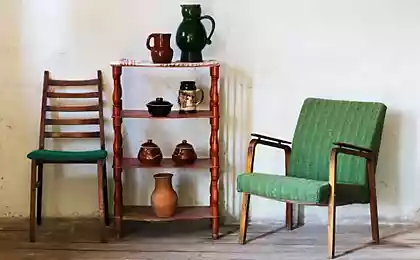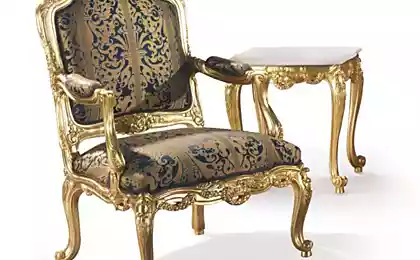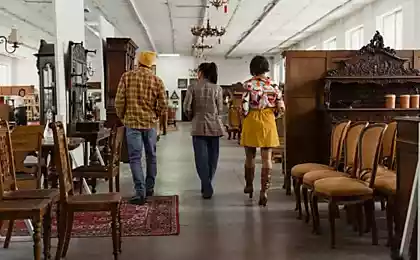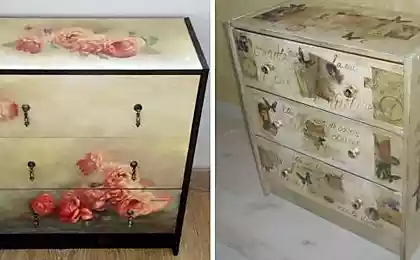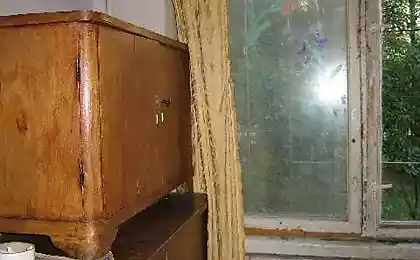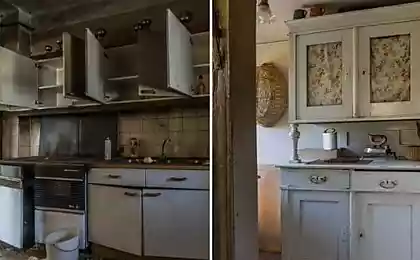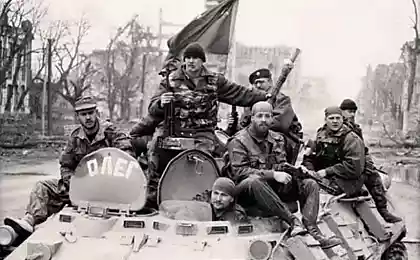1501
For those who are gnawing nostalgia
In the kitchen cupboard with kitchenware and a round table in the middle. In the hall cupboard with crystal, a sofa bed, a floor lamp with large shade. The bedroom chair bed and covering an entire wall carpet ... Looking for padded leatherette door usual "Khrushchev", "RG" offers readers older indulge nostalgia. But especially useful story about a typical Soviet apartment interior items will be for those who have no clue what the words "bookcase" and "trellis".
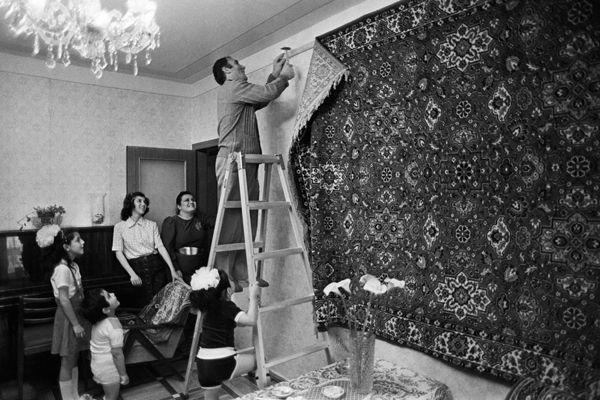
"What a mess! The house has very thin walls and neighbors hear everything that happens in our apartment, "- one woman complained to her friend. "So hang on a wall carpet!" - She advised. "But then we will not hear what the neighbors are doing!" - She heard in reply.
Laugh at this old joke in the Soviet era could not all, because the problem of sound insulation in buildings to the jokes do not have. How, by the way, and insulation - sleeping in the cold brick wall or panel was quite uncomfortable.
At the same time, carpets perform an aesthetic function. This, of course, were not pre-revolutionary precious tapestries, but they are much more pleasing to the eye Soviet faded wallpaper with primitive drawings. Basically, the carpets were bright red or burgundy color with intricate symmetrical patterns or exquisite plants. However, it is more about 1970-1980 years. And before that hung on the walls are thin mats of material such as plush - framed fringe and, as a rule, with deer or swans.
Demand for wall hangings - with their relatively high price - was incredibly high. Queue behind them stretched into months, and wishing you had pre-recorded and regularly come to the store to "mark". In this situation, craftsmen, artists have tried to offer a more affordable alternative. Familiar to image tissue learned applied to plywood sheets, other masters earned money by painting traditional reindeer on oilcloth. Here, of course, about the sound or heat insulation of the question. But - as with all.
By the way, the carpet on the wall might well not be combined with carpeted floors. They also had a lot to almost any flat, but in this case the price is not pursued - expensive carpet and did not want to trample. Usually on the floorboards or parquet lay narrow paths with colored piping on the edges, and ordinary woven rugs.
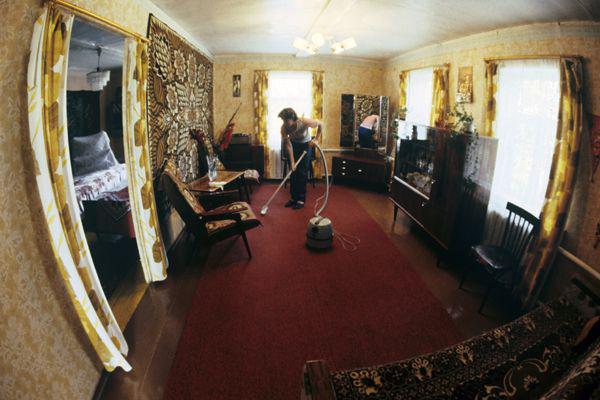
There is an opinion that the expression "round table" - the one that, for discussion of topical issues like organizing officials and public figures - were born on the Soviet kitchen. Here, sitting on the stool round, in a literal sense, the table often sat up family members and their guests, discussing the key speeches at the last congress of the Communist Party or the situation with a deficit of products.
Indispensable attribute of the table had a tablecloth. Usually - simple linen, but a good housewife in case guests arrive store and lace. If the house were children, for them during lunch over the fabric tablecloths often made the checkered oilcloth.
However, the Soviet furniture makers engaged in mass production of these tables is not because of their convenience for discussion. Perhaps no other model is not allowed to place at the same time as cutlery and, in fact, consumers in the compact kitchen "stalinki».
In the "Khrushchev" does not fit already and such tables, and soon they came to replace the small rectangular tables, size resembling coffee. Organize gatherings in distress, understandably, have ceased. And lunch or dinner, especially solemn and if they were invited guests, was carried out in the hall. There usually was a large polished table of two tabletops Spreads between them - to heighten the scope - can be inserted and the third.
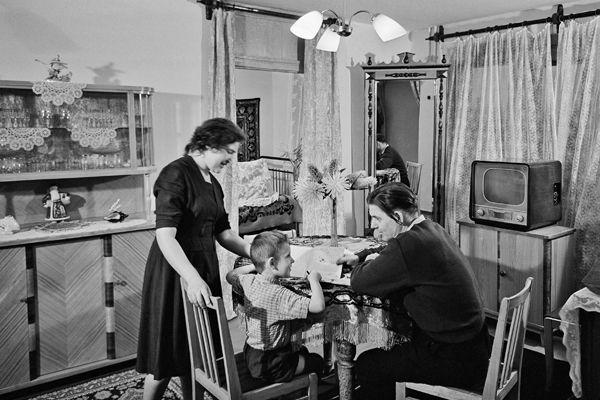
No less traditional items of kitchen furniture Soviet was buffet - small narrow cupboard with doors, often - a glass in which the hostess kept the dishes. However, it is usually enough for couples and private offices. But in the open could be the envy of guests to keep the most expensive items - such as porcelain or crystal.
In the 1980s, this glittering wealth will move into the hall - in the glass sections of so-called "wall", which are still often present in the interiors of apartments. But at first instead of them standing dressers - cabinets on legs, consisting of two parts. The lower, wider, usually had three private offices, at the top - narrower - certainly a niche left glazed with transparent shelves. At first, here put souvenirs, frames with pictures of family and images of popular artists clay figurines of dogs and birds, later replaced by Khokhloma or Dymkovo toy. Then sideboards decorated the incredible beauty of vases, salad bowls and tea sets, which are usually carried solely aesthetic function. Get them literally on major holidays. One of the shelves apartment owners could take and books - there are two-three series subscriptions also served as a source of pride of their owner.
Note that for the books - in addition to the banal shelves - designed and almost forgotten now whatnot mentioned in a poem by Boris Zakhoder from "Winnie the Pooh and all-all-all": "Silent bookcase, couch and silent - they will not achieve the answer, Why CTA is - certainly that. A Zherko usually this! "The answer can be assumed: couch - sofa without back - usually stood in the back of the room, but still covered with a blanket. A bookcase - a few shelves, which are located between the carved, sometimes delicate, feet-resistant, - always in mind. In addition to books (of course, not too heavy) could stand here all kinds of boxes and boxes for storing the necessary detail and souvenirs.
The bedroom was a mandatory wardrobe - a massive wardrobe, including the top. When he was a three-door, mid necessarily mirror fastened. And next to the bed by the window or standing - unless, of course, allows funds to buy it - a wide, but the low dresser with a couple-three drawers. They could hide, for example, a couple of sets of bed linen, blankets unclaimed folded shirt. In general, a dresser replaced in Soviet apartment is not nothing like grandma's trunk.

Dressers and can often be found in modern apartments. Above them often hang high mirrors in wooden frames to the hostess could freshen up before going out. In Soviet times, for this procedure served as a special dressing table with shelves and mirror - mirror.
Its modification became fashionable trellis consisting of three mirrors. One - the bigger - is attached directly to the base, made in the form of tables, and two side hung on small hinges already on it. Turn sash lady could see his hair almost back. Especially needed trellis lovers sew - now where you can see in detail how "sitting" dress or blouse.
By the way, stands and could stand in the corridor, unless, of course, allows its area. In both cases, on the dressing table could find "a thousand little things." In the bedroom - a bottle of perfume, lipstick, combs and jewelry, in the hallway - keys, coins, newspapers from the box. Often the captain closed the glass table, under which lay the bus schedule, the schedule of supply of water in the house or the poster premier at the local theater. Suddenly, you will need to take a look before leaving the house ?!
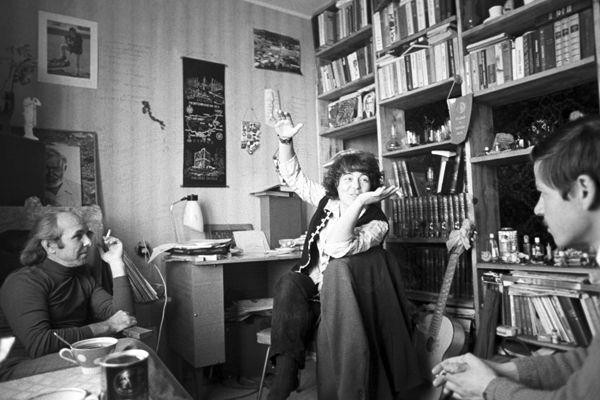
The aforementioned couch really was not popular, as, by the way, and sofa. Most likely because both occupy a lot of space in a small apartment, though not much comfort delivered. Usually ottomans, if so any, was used instead of the children's sofas or as a place for guests.
In the 1980s, furniture makers bearings, and began to make a shortened couch with sliding sections, which it would like to lengthen. Naturally, it was not at all know-how: Transformers do then for every taste. Success, for example, used a table-book, which, if necessary (or rather - that without it) folded to the size of a narrow low cabinet. But the peak of fashion considered sofas-book (sofa bed) and armchairs, which were almost mandatory set for the living room and even more so - for the bedroom. Even if these items are not very suited to each other and different from, say, armrests or the color of the upholstery, covered by a huge and inexpensive carpets (where they just do not use!), They can be put in the form set. Happy in this room was convenient to get together to watch TV or socialize in the evening lounge is easily converted into a bedroom.
And, of course, not to mention iron beds of armored mesh. They first appeared in the 1930s, they were sleeping in the war years, in some places these are found so far. Often on the narrow bed had to huddle spouses. In the dream, they naturally slid into the middle and not only interfere with each other to sleep, but the stretched mesh. So under the "hammock" is often underlay sheets of plywood or even unnecessary wooden doors. However, for such beds is unlikely someone nostalgic - as they say, and do not want to remember.

But certainly need to remember the floor lamp with shade and chandelier "Cascade", remind Czech crystal. The first gave the room an extraordinary comfort, the second - reliability: it was another symbol of prosperity of the Soviet family. The fact that for the mass consumer "crystal" made of plastic - it seemed only an advantage, because every now and then pleasing to the eye "blestyashki" with the chandelier turned out on the floor. They touched his head, his hands moving through the apartment furniture, children often bring them down, firing defeat of toy guns or throwing balls rolled in paper. "Tassels" as they are called toddlers fall, but not broken.
As for floor lamps, then the trick was in color fabric lampshade - ideally he should repeat the color of curtains. However, in recent years began to appear and plastic lampshades with glass inserts. In this case, the color of the case were selected to match the furniture. Standing floor lamp beside the chair and not a substitute for a nightlight at the head of the sofa - table lamp with a little shade or bubble. By and large, both of these devices are used mainly during the reading - reading in the Soviet era, and many did not tape the events in a social network.
The alternative of the book is, of course, television. At first they were black and white, then - in the late 1960s - appeared and color. Demand for "Ruby", "record", "Rainbow" and "pace" with their rather high price seemed incredible. TV is almost always took place in a corner of the large room - so that the opposite can be comfortably positioned as many viewers. And at first, when television first appeared, see news release, film or concert often called not only relatives, but neighbors. Note that the television sets blended well with the interior of virtually any flat because their body makes, usually made of plastic, imitating the color and texture of wood.
As for the other receiver - radio, it is most often placed on the refrigerator in the kitchen, or hung on the wall in the corridor, unless permitted length of wire to radios. By the way, often served as a radio alarm function ... than could boast traditional massive striking clock. Because the radio signal is not broadcast at night, in the evening put the receiver at full volume, and exactly at 6 am the whole family jumped at the first sound of the radio call sign or the Soviet anthem.
Finally, let us recall another indispensable accessory Soviet apartment - disk phone, crackling call which could add vigor at any time. Most often, the machine (long they differ only in color) was placed in the hallway - it even sold special shelves with carved legs. Near the same huddled stool: conversations sometimes lasted so long that it was simply impossible to resist.
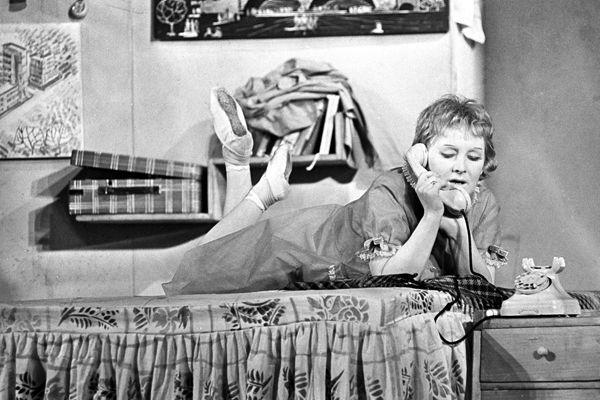
P. S.
If the Soviet houses and apartments were not similar to each other, Eldar Ryazanov would not have made the famous film "Irony of Fate, or Enjoy Your Bath". However, in this case, we would be looking at other movies. Because it would be a completely different country.
--img8--
Source: www.rg.ru

"What a mess! The house has very thin walls and neighbors hear everything that happens in our apartment, "- one woman complained to her friend. "So hang on a wall carpet!" - She advised. "But then we will not hear what the neighbors are doing!" - She heard in reply.
Laugh at this old joke in the Soviet era could not all, because the problem of sound insulation in buildings to the jokes do not have. How, by the way, and insulation - sleeping in the cold brick wall or panel was quite uncomfortable.
At the same time, carpets perform an aesthetic function. This, of course, were not pre-revolutionary precious tapestries, but they are much more pleasing to the eye Soviet faded wallpaper with primitive drawings. Basically, the carpets were bright red or burgundy color with intricate symmetrical patterns or exquisite plants. However, it is more about 1970-1980 years. And before that hung on the walls are thin mats of material such as plush - framed fringe and, as a rule, with deer or swans.
Demand for wall hangings - with their relatively high price - was incredibly high. Queue behind them stretched into months, and wishing you had pre-recorded and regularly come to the store to "mark". In this situation, craftsmen, artists have tried to offer a more affordable alternative. Familiar to image tissue learned applied to plywood sheets, other masters earned money by painting traditional reindeer on oilcloth. Here, of course, about the sound or heat insulation of the question. But - as with all.
By the way, the carpet on the wall might well not be combined with carpeted floors. They also had a lot to almost any flat, but in this case the price is not pursued - expensive carpet and did not want to trample. Usually on the floorboards or parquet lay narrow paths with colored piping on the edges, and ordinary woven rugs.

There is an opinion that the expression "round table" - the one that, for discussion of topical issues like organizing officials and public figures - were born on the Soviet kitchen. Here, sitting on the stool round, in a literal sense, the table often sat up family members and their guests, discussing the key speeches at the last congress of the Communist Party or the situation with a deficit of products.
Indispensable attribute of the table had a tablecloth. Usually - simple linen, but a good housewife in case guests arrive store and lace. If the house were children, for them during lunch over the fabric tablecloths often made the checkered oilcloth.
However, the Soviet furniture makers engaged in mass production of these tables is not because of their convenience for discussion. Perhaps no other model is not allowed to place at the same time as cutlery and, in fact, consumers in the compact kitchen "stalinki».
In the "Khrushchev" does not fit already and such tables, and soon they came to replace the small rectangular tables, size resembling coffee. Organize gatherings in distress, understandably, have ceased. And lunch or dinner, especially solemn and if they were invited guests, was carried out in the hall. There usually was a large polished table of two tabletops Spreads between them - to heighten the scope - can be inserted and the third.

No less traditional items of kitchen furniture Soviet was buffet - small narrow cupboard with doors, often - a glass in which the hostess kept the dishes. However, it is usually enough for couples and private offices. But in the open could be the envy of guests to keep the most expensive items - such as porcelain or crystal.
In the 1980s, this glittering wealth will move into the hall - in the glass sections of so-called "wall", which are still often present in the interiors of apartments. But at first instead of them standing dressers - cabinets on legs, consisting of two parts. The lower, wider, usually had three private offices, at the top - narrower - certainly a niche left glazed with transparent shelves. At first, here put souvenirs, frames with pictures of family and images of popular artists clay figurines of dogs and birds, later replaced by Khokhloma or Dymkovo toy. Then sideboards decorated the incredible beauty of vases, salad bowls and tea sets, which are usually carried solely aesthetic function. Get them literally on major holidays. One of the shelves apartment owners could take and books - there are two-three series subscriptions also served as a source of pride of their owner.
Note that for the books - in addition to the banal shelves - designed and almost forgotten now whatnot mentioned in a poem by Boris Zakhoder from "Winnie the Pooh and all-all-all": "Silent bookcase, couch and silent - they will not achieve the answer, Why CTA is - certainly that. A Zherko usually this! "The answer can be assumed: couch - sofa without back - usually stood in the back of the room, but still covered with a blanket. A bookcase - a few shelves, which are located between the carved, sometimes delicate, feet-resistant, - always in mind. In addition to books (of course, not too heavy) could stand here all kinds of boxes and boxes for storing the necessary detail and souvenirs.
The bedroom was a mandatory wardrobe - a massive wardrobe, including the top. When he was a three-door, mid necessarily mirror fastened. And next to the bed by the window or standing - unless, of course, allows funds to buy it - a wide, but the low dresser with a couple-three drawers. They could hide, for example, a couple of sets of bed linen, blankets unclaimed folded shirt. In general, a dresser replaced in Soviet apartment is not nothing like grandma's trunk.

Dressers and can often be found in modern apartments. Above them often hang high mirrors in wooden frames to the hostess could freshen up before going out. In Soviet times, for this procedure served as a special dressing table with shelves and mirror - mirror.
Its modification became fashionable trellis consisting of three mirrors. One - the bigger - is attached directly to the base, made in the form of tables, and two side hung on small hinges already on it. Turn sash lady could see his hair almost back. Especially needed trellis lovers sew - now where you can see in detail how "sitting" dress or blouse.
By the way, stands and could stand in the corridor, unless, of course, allows its area. In both cases, on the dressing table could find "a thousand little things." In the bedroom - a bottle of perfume, lipstick, combs and jewelry, in the hallway - keys, coins, newspapers from the box. Often the captain closed the glass table, under which lay the bus schedule, the schedule of supply of water in the house or the poster premier at the local theater. Suddenly, you will need to take a look before leaving the house ?!

The aforementioned couch really was not popular, as, by the way, and sofa. Most likely because both occupy a lot of space in a small apartment, though not much comfort delivered. Usually ottomans, if so any, was used instead of the children's sofas or as a place for guests.
In the 1980s, furniture makers bearings, and began to make a shortened couch with sliding sections, which it would like to lengthen. Naturally, it was not at all know-how: Transformers do then for every taste. Success, for example, used a table-book, which, if necessary (or rather - that without it) folded to the size of a narrow low cabinet. But the peak of fashion considered sofas-book (sofa bed) and armchairs, which were almost mandatory set for the living room and even more so - for the bedroom. Even if these items are not very suited to each other and different from, say, armrests or the color of the upholstery, covered by a huge and inexpensive carpets (where they just do not use!), They can be put in the form set. Happy in this room was convenient to get together to watch TV or socialize in the evening lounge is easily converted into a bedroom.
And, of course, not to mention iron beds of armored mesh. They first appeared in the 1930s, they were sleeping in the war years, in some places these are found so far. Often on the narrow bed had to huddle spouses. In the dream, they naturally slid into the middle and not only interfere with each other to sleep, but the stretched mesh. So under the "hammock" is often underlay sheets of plywood or even unnecessary wooden doors. However, for such beds is unlikely someone nostalgic - as they say, and do not want to remember.

But certainly need to remember the floor lamp with shade and chandelier "Cascade", remind Czech crystal. The first gave the room an extraordinary comfort, the second - reliability: it was another symbol of prosperity of the Soviet family. The fact that for the mass consumer "crystal" made of plastic - it seemed only an advantage, because every now and then pleasing to the eye "blestyashki" with the chandelier turned out on the floor. They touched his head, his hands moving through the apartment furniture, children often bring them down, firing defeat of toy guns or throwing balls rolled in paper. "Tassels" as they are called toddlers fall, but not broken.
As for floor lamps, then the trick was in color fabric lampshade - ideally he should repeat the color of curtains. However, in recent years began to appear and plastic lampshades with glass inserts. In this case, the color of the case were selected to match the furniture. Standing floor lamp beside the chair and not a substitute for a nightlight at the head of the sofa - table lamp with a little shade or bubble. By and large, both of these devices are used mainly during the reading - reading in the Soviet era, and many did not tape the events in a social network.
The alternative of the book is, of course, television. At first they were black and white, then - in the late 1960s - appeared and color. Demand for "Ruby", "record", "Rainbow" and "pace" with their rather high price seemed incredible. TV is almost always took place in a corner of the large room - so that the opposite can be comfortably positioned as many viewers. And at first, when television first appeared, see news release, film or concert often called not only relatives, but neighbors. Note that the television sets blended well with the interior of virtually any flat because their body makes, usually made of plastic, imitating the color and texture of wood.
As for the other receiver - radio, it is most often placed on the refrigerator in the kitchen, or hung on the wall in the corridor, unless permitted length of wire to radios. By the way, often served as a radio alarm function ... than could boast traditional massive striking clock. Because the radio signal is not broadcast at night, in the evening put the receiver at full volume, and exactly at 6 am the whole family jumped at the first sound of the radio call sign or the Soviet anthem.
Finally, let us recall another indispensable accessory Soviet apartment - disk phone, crackling call which could add vigor at any time. Most often, the machine (long they differ only in color) was placed in the hallway - it even sold special shelves with carved legs. Near the same huddled stool: conversations sometimes lasted so long that it was simply impossible to resist.

P. S.
If the Soviet houses and apartments were not similar to each other, Eldar Ryazanov would not have made the famous film "Irony of Fate, or Enjoy Your Bath". However, in this case, we would be looking at other movies. Because it would be a completely different country.
--img8--
Source: www.rg.ru











